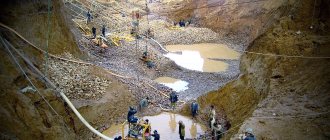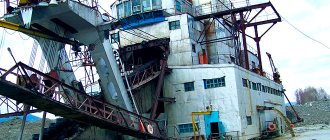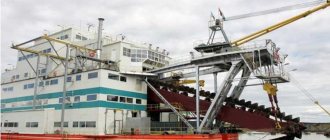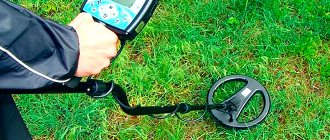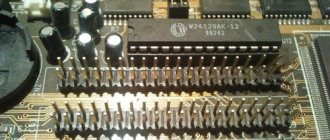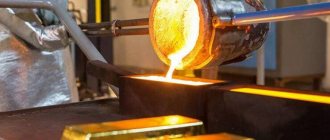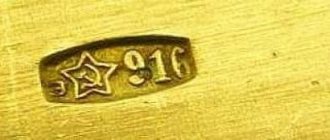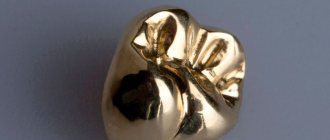This article was born in connection with the increased interest in gold mining. I often get asked questions about how to get gold from streams and rivers? How to make a gateway for gold mining with your own hands? Where and what kind of gateway should I buy? How to make a passage with your own hands?
In this article I will tell you how to make a gateway with your own hands. The equipment is so simple that anyone can make it in a couple of hours at home and it will be in many ways better than a purchased American aluminum sluice, the cost of which in Russia reaches 17,000 rubles. I’ll tell you how to properly make a gold-catching sluice, a mini device for gold mining colloquially called prodnushka. This is what the prospectors of Siberia and the Urals call it, the name that came to us from our grandfathers and great-grandfathers is prodnushka.
A passage (sluice) is a box made of three boards, at the bottom of which a mat is laid and a stencil (riffle) is placed. A walk-through made of wood is not only simpler and cheaper than one made of aluminum, but most importantly, if something happens, you won’t mind throwing it away. If you use dry and not thick wood, then the weight will be no more than that of an aluminum analogue, and with a skillful approach, even less. In addition, wooden boards in your car or backpack will not raise questions from strangers; no one will ask what kind of boards they are or ask unnecessary questions. You never know what purpose you need these boards for in the forest.
To make a passage (sluice) for gold mining, the main thing is to follow the basic simple rules in its manufacture, and you will be a more successful gold miner than other prospectors with short purchased sluices.
Gateway length.
The longer the hole, the more gold you will catch. Foreign aluminum sluices have a maximum length of 1.5 meters; this is not enough to catch fine gold and disintegrate poorly washed sands or loams. The length of foreign locks is 1.5 meters due to legislation that limits the length of the lock, so that amateur tourists do not wash out all the gold on the stream and leave it to others. For example, in America, Australia, and New Zealand, gold mining is a hobby, like picking mushrooms or fishing in our country.
The width of the sluice depends on the amount of rock supplied; for bucket feeding, a width of 20-25 cm is sufficient.
To make a long and easy-to-carry passage, use a cascade of gateways, for example, install two gateways of 1.5 meters in series, for a total of 3 meters. This is enough to catch fine gold and disintegrate the rock. If the soil is clayey and does not have time to be washed through the passage, you need to use other equipment called butara. I will talk about it in the following articles or videos on my channel https://www.youtube.com/user/RudolfKavchik
Installation of riffles or as they are also called stencils.
The stencil is the most important part of the pass-through. Behind them, a turbulence of the water flow and its rarefaction occurs. This creates conditions for the accumulation of the heavy fraction behind the riffle plates and the demolition of light unnecessary material. The angle of inclination of the riffle plates depends on the amount of water supplied to the passage and can be from 45 to 78 degrees. The greater the depth of the flow and the speed of the flow of water supplied to the sluice, the greater the angle of inclination of the riffles. The distance between the riffles is 5-7 cm. The shape of the riffles can be straight or with slightly curved edges in the direction of flow.
If the water flow is weak, then riffles are not used. The rock is sifted through a sieve before being fed to the mini device. See the chapter on material screening below.
Gold catching mat.
A gold catching mat can be made from any natural fabric, such as burlap, tarpaulin, and even an ordinary waffle towel that housewives use in the kitchen will do. The main purpose of the mat is to ensure that the riffles adhere to the bottom of the sluice so that the accumulated material is not washed away by the leaking flow under the riffles.
Industrial enterprises use cellular gold-collecting mats. This is due to the technological process of gold mining. The rock is transported to the industrial equipment by multi-ton Belaz trucks, washing thousands of cubic meters of gold-bearing rock per day. Each Belaz truck contains ten grams of gold, which is brought in for washing every few minutes. It is not profitable for the enterprise to stop the washing process to unload the industrial equipment; this will require stopping production for 2-3 hours, and time is gold, in the literal sense of the word. The industrial device is unloaded once a day. Due to the large amount of washed rock, there was a need for cellular mats with a high profile, which accumulate heavy metal and prevent it from being carried away by the flow of water, which increases the time of effective operation of the industrial device.
At its core, a honeycomb mat works like a stencil/reel. In the depths of the cells, vortex flows are created that carry away light particles of sand, leaving heavy metals at the bottom: gold, platinum. In the passageway, a cellular mat can not be used, since the rock for washing is not supplied by dump trucks, and gold can be easily removed at any time. as heavy material accumulates. In addition, a cellular mining mat is not easy to obtain and its cost of several thousand rubles is not at all justified when used on mini devices.
You can make an analogue of a cellular mat yourself from an ordinary household cellular mat, which many people have on their porch and is sold in every hardware store under the name “anti-slip coating.” The mesh size of the anti-slip coating is approximately 5 mm. See photo.
The anti-slip coating is laid on top of the rag mat. Ribbons are installed on top. Such a system will work no worse than an industrial rug, it’s easier to buy, and its cost is much lower, and if something happens, you won’t mind throwing it away.
To be continued…
Hello, dear readers! Today we will plunge into the world of gold mining and examine one of the main methods of extracting this metal. After all, not everyone knows exactly how it is taken out of the ground and separated from other garbage.
The problem is that in addition to pure nuggets, the noble mineral is found in the soil. For the purpose of its removal, a device was invented, which will be discussed further - a dredge for extracting gold.
Gold is considered an expensive, but still not a rare metal. Its methods are conventionally divided into mechanical and chemical (when combined with other elements). If we talk about the Russian Federation, the following are recognized as the main ones.
- Amalgamation is based on the special property of mercury to dissolve elements in itself. The rock containing gold is placed in a container with Hg. Over time, these metals combine to form an amalgam, from which the mercury is subsequently evaporated.
- Crystallization using NaCN - this method is very similar to the previous one, only instead of poisonous mercury, the gold-bearing rock is mixed with sodium cyanide, which, when combined with gold, forms yellow crystals.
- The dredge method is the use of a special floating installation (dredge), which collects enriched rock and washes out the precious metal from it.
These are the main methods of industrial gold mining in Russia. In addition to them, manual washing using a sieve is also widespread.
What is a dredge?
Dredges are special machines designed to work with different types of soil. The main functioning element of such installations can be either a multi-bucket in-line mechanism or a suction hose (if the rock is loose). The scooping mechanism is adjusted by a staff of 10 people.
Simply put, this unit acts as an attachment that can be installed on a floating platform or ground transport, and is somewhat reminiscent of a conveyor. Only instead of a tape, movable scooping devices are attached to the frame. They are the ones who scoop out gold-bearing ore from a quarry or from the bottom of seas, oceans, rivers, etc. Subsequently, the extracted conglomerate containing the required element is transported for processing. Below is a photo of the car itself.
Dredge device
If we talk about a dredge with a bucket working element, then there is nothing complicated in its design. However, there is also a vacuum type of installation, the design of which is different in many respects. It is intended for bulk deposits, which include marine gold-bearing sands. The machine consists of the following mechanisms.
- Pump - creates a suction effect.
- Sleeve - passes rock through itself under the influence of a created vacuum.
- Auxiliary hose - connected to a pump that pumps water, and directs it through a high-pressure pipeline into the hose.
- A sluice is a kind of container that calibrates the rock and throws away large debris.
- Butara - acts as a flushing mechanism.
All these elements work harmoniously, that is, together. Most often they are installed on a floating gold mining platform that operates on water. They are rarely used in quarries.
Principle of operation
Gold ore particles are purified from rock in several stages:
- The electric motor turns on and the pump directs water into the pressure hose, thereby discharging the space between the river water and the suction tip.
- Due to the vacuum formed, the soil is drawn in by the suction nozzle and moves along the supply hose to the flushing sluice.
- Once there, the soil and water pass through a certain system of drops. The goal here is to separate the denser gold from the lighter rock particles.
- Then, after a certain time, the gold settles in the gutter, and the remaining soil is removed into the river along with the flushing water.
Before the actual start of the washing process, the dredge is adjusted to ensure the accuracy of catching the precious metal. This is done by adjusting the overflow differential, flow and pressure of the pump.
To ensure greater reliability of the correct operation of the dredge, a preliminary check is carried out, which consists of passing pieces of lead marked with paint through it. If, after passing through the sluice gate, painted metal is observed in the chute, then the dredge is working properly. If not, then it is sent for revision.
Operating principle of the dredge
Dredge equipment, regardless of whether it is a pump or a bucket, is designed for one purpose - the extraction of ore containing valuable minerals and its transportation to the destination, that is, to the place where the mined material is either processed or immediately washed (as in the case with gold).
For example, a bucket dredge most often simply dumps the mined conglomerate into a heap, but a floating pumping station immediately washes and collects pure gold, throwing unnecessary debris to the bottom. But the principle is the same - extract, transport and sift.
Tools for prospectors and geologists
A wide selection of tools and accessories for prospectors and geologists from American manufacturers - plastic and steel trays, classification sieves, separators, portable mini-sluices, screens, geological hammers, magnifying glasses, compasses, magnets for removing iron impurities, scales, scribers and much more.
Equipment supply lists (with brief characteristics)
2015 (PDF, 1.55 MB) 2016 (PDF, 1.11 MB) 2017 (PDF, 1.38 MB) 2018 (PDF, 2.71 MB) 2020 (PDF, 3.05 MB)
Classification
The global specification distinguishes two main types of machines.
- 1st class (quarry dredges) - work in artificially created reservoirs on floating platforms.
- Class 2 (water dredges) - designed for the extraction of bulk rocks from the bottom of seas, lakes, etc.
In addition, dredge installations can be divided depending on their design features and capabilities.
- By type of energy used.
- According to the method of movement.
- Depth of extraction.
- Depending on the type of bucket.
- According to the size of the scoop.
- Method of operation of the bucket chain.
There are quite a few different classifications of installations, but the main one is considered to be the world one, that is, 1st and 2nd classes.
Mini dredge
Another variety is a compact unit that resembles a full-fledged pumping dredge platform. At its core, this is the same installation, only in a smaller version and, accordingly, with limited productivity. It is used mainly by hired miners engaged in legal gold mining.
Classification of dredges
Dredges are grouped:
- by the type of energy required for the operation of the device: electricity, energy from the combustion of gasoline or diesel fuel vapors;
- by depth of work with rocks below the water level: shallow-water, deep-water;
- by bucket capacity: small, medium, large;
- by maneuvering method: rope-pile, rope-anchor.
As a rule, two types of special machines are used for gold mining:
- marine;
- continental.
These types of dredges differ in that the marine special vehicle is similar to a ship that can be moved along the coast, while the continental one requires more resources, as it is mounted on a pontoon.
Smaller special vehicles called mini-dredges are ideal for individual gold miners or prospectors. They can either be purchased in special stores or made independently. The mini-drag has been significantly reduced in size. Its weight ranges from 25 to 100 kg.
A positive feature of using mini-dredges is that they reduce labor costs and speed up the gold mining process. Therefore, the interest of miners in constructing the unit with their own hands at home is justified.
How to check the flushing unit?
Before mining gold, the equipment should be thoroughly checked. The bottom line is to test the gateway for performance, namely, the capture of small particles of gold from the ore. To do this, take some dense metal, for example, lead, and paint it in a bright color. After this, it is poured into a portion of soil and washed.
Thus, the dredge will catch brightly colored metal no worse than gold. If only 2-3 pieces are lost in the process, then the unit can be considered quite serviceable, and in practice it will perform well.
Stone crushers
Stone crushers for grinding platinum-bearing and gold-bearing rocks (usually quartz) into powder. The American company Keene Engineering, Inc produces two models - a portable mini crusher RC1 of a centrifugal operating principle with a gasoline engine, a loaded fraction of up to 2-3 cm, and a mobile crusher RC46 on a trailed chassis with wheels, a fraction of up to 15 cm. RC46 is also available on a stationary stand , and is equipped with an electric or gasoline engine.
Is it possible to make a dredge with your own hands?
Based on what was written above, it is theoretically possible to make a mini dredge, but you will have to buy some additional parts. In any case, it will be much cheaper than purchasing a new device (about 3 times). However, it is not a fact that a device assembled by yourself will work well. When designing, you need to take into account many nuances.
Required tools, materials and components
Self-production only involves assembling all the mechanisms into one whole, since it is almost impossible to construct them with your own hands. The list of what you will have to buy consists of the following units.
- Motor - it will turn the main elements.
- Pump - a centrifugal water pump is suitable.
- Compressor - needed to produce air for breathing underwater.
- Pipes are a readily available material.
I would like to draw your attention to the fact that the pump and compressor must be attached to the motor and use its energy to function. Therefore, when purchasing, you need to ensure that their installation is as simple as possible.
You can also buy a gateway, but it’s quite possible to make it yourself. To do this, you will need aluminum profiles, galvanization and metal of various shapes.
General form
Conventionally, mini dredges are divided into portable and stationary (more productive). The latter are considered more cost-effective because they can operate in deeper bodies of water and are equipped with a compressor to generate air so that the miner can remain under water for a long time. General diagrams and drawings of such installations are presented below.
Gateway drawing Gateway diagram General dredge operation diagram General view of the installation
In addition to these, there are also so-called hand dredges, which are convenient to work with in shallow water or in streams. The principle of operation is the same, only all the equipment is attached very compactly, which allows you to carry it in your hands. The unit itself is somewhat reminiscent of a vacuum cleaner for gold.
How to buy a mini dredge?
Mini dredging is an effective way to mine gold, which determines its continued demand among miners.
You can buy a fully equipped mini dredge at an affordable price from.
A mini dredge for gold mining, the price of which will be a maximum of 75 to 140 thousand rubles, depending on the model’s configuration, but by speeding up the gold mining process, it alone can replace several dozen people with manual trays and significantly reduce labor costs.
You can make a mini dredge yourself, but in this case you will need certain knowledge about the extraction of placer gold, and you will also need to make certain components. Therefore, it is better to entrust the production of equipment to professionals who know their business in this area! For example, the question will arise where to buy a lower ejector and an upper ejector for a mini dredge. The answer is simple - you can buy components and equipment for mini dredges at. It should be taken into account that the mini dredge will require increased attention and permanent improvement, and installation will take about one month. If you want a mini dredge for gold mining to be highly enriched and to last a long time without losing its functionality, it is better to purchase ready-made equipment with a number of additional advantages.
Work progress
So, you need to start building a dredge for gold mining with a frame for which metal profiles are suitable. It can be of any shape, but it is advisable to make it so that it is easy to install attachments later.
After collection, floating elements (tanks, barrels, hollow pipes) are installed on the created base, which will allow the entire installation to move freely on the surface of the water.
When the main part is ready, you can attach the motor to the frame, and then the pump and compressor to it. Then, accordingly, install pipes - one for collecting water, the second for supplying it under pressure, the third, the most massive, for collecting ore, sand, etc.
The last thing to install is a gateway, which is connected to the main hose, after which the homemade mini dredge is checked. To better understand exactly how it works, you can watch the video.
What is a tray? Why do you need a magnet?
A prospecting tray is a trough, a basin with low sides. There are few requirements for it: it should not sink, but should be durable and light.
The material can be very different. The ancient Greeks used skins for this purpose. There are still trays made of wood, mostly linden. Such trays are not painted, leaving a rough wood structure. Often the tool is made of metal or steel. The simplest option is plastic.
The shape can be round or elongated in the form of a trough. People learn to work with such a tray from childhood.
The color of the material is dark so that light grains of precious metal can be seen on it.
The miner's bag should have a magnet to remove metallized ore from the sand and a bulb bottle, which will be needed at the final stage of washing.
How to pan or mine gold yourself using a mini dredge?
Before engaging in such a matter, you need to know what is punishable in accordance with current legislation. However, this does not stop gold miners, which results in the widespread spread of this fishery in the eastern part of Russia.
You can work with such a device both on land and in reservoirs, but in both cases a water supply is required. In the first, the ore will enter the gateway under the influence of injection, and in the second, it will be done manually, that is, you will have to work with a shovel. There is no particular difference between these methods, and they are both applicable.
Tray and shovel - miner's weapons
Through temporary labor agreements with licensed miners, or other semi-legal schemes, miners today pan for gold by hand, just as their counterparts did in American films years ago.
The use of any equipment that facilitates this work is prohibited. All that artisans can use is a tray and a shovel, and sometimes a metal detector. In addition, they often work in such remote and hard-to-reach places that no equipment simply can get there.
Place of Birth
One of the largest deposits in Russia, one of the top five in the world ranking, Olimpiada, is located in the Krasnoyarsk Territory; gold mining here began in the 80s of the last century. The following regions of the Russian Federation belong to gold mining areas:
- Yakutia (Verkhoyansk and Aldan regions);
- Amur region;
- Eastern part of Siberia (Bodaybo, East Transbaikal, Yenisei and Prilensky regions);
- Far East;
- Primorsky Krai.
Gold in the total mass of the earth's crust is only 0.000001%; it is a component of many chemical and physical substances, even in the human body, however, it is found in the earth in atomized form. And deposits of the precious metal are the places with the highest concentration. Such deposits are divided into two types:
- indigenous;
- placer.
Deposits of the precious metal of the indigenous type were formed in the bowels of the earth many thousands of years ago under the influence of magmatic processes. In such places, gold can rarely be found in its pure form; most often it is a component of a complex alloy.
Secondary or alluvial deposits were formed as a result of various types of impacts on primary deposits (chemical or physical).
As a result of the activity of microorganisms, temperature fluctuations, and under the influence of wind and water, the metal in the bedrock begins to descend into river valleys and settle there, forming a placer deposit. Here, gold is more accessible to mining, since the bedrock must be extracted from the ground, sometimes the depth of its deposits reaches several hundred meters. The largest Russian deposits of the indigenous type, of which the following can be distinguished:
Geographical location of the gold deposit, Sukhoi Lug
- Sukhoi Log;
- Berezovskoe;
- Vorontsovskoe.
The sites of significant gold deposits discovered in the Eastern part of Siberia were united into one mining zone - Sukhoi Log, industrial production here began in 1961 and continues to develop actively.
The deposit is one of the largest in Russia, however, its vein is characterized by a low metal content, and for gold mining to be effective it is necessary to process large volumes of earth rock. The average precious metal content is 2.7 grams per ton of ore, although there are places with a high gold content of up to 10 grams per ton.
The Berezovskoye deposit is unique; it was discovered in the 17th century, and the first significant mining work began in 1748. Since its foundation, about 140 tons of yellow metal have been mined here; it is dusty, small, it is classified as industrial grade C1 and C2, partial inclusions are noted in sulfide compounds, very rarely in the form of nuggets. However, according to expert estimates of specialists in the Berezovskoye field, reserves amount to 90 tons.
The Vorontsovskoye field is located in the Sverdlovsk region
The Vorontsovskoye deposit is located in the Sverdlovsk region, it was discovered in the 80s, but active gold mining here began at the end of 2000. The precious metal is represented by oxidized friable ores and gold-sulfide rocks.
The metal is found in the form of alloys with rock minerals, and in rare cases nuggets are found, but small ones, mostly up to 0.5 mm thick. This is the first deposit in the country where the technology of leaching metal from ore in winter was used, which made it possible to mine all year round.
Everything must be according to the law
On the territory of the Russian Federation there are many laws relating to the development of mineral resources, including the extraction of precious metals. Here are just a small part of them:
- “Rules for the extraction, production, use, circulation, receipt, accounting and storage of precious metals and stones.”
- Law “On Environmental Protection”.
- Federal Law “On Precious Metals and Stones”.
- Article 171 of the Criminal Code of the Russian Federation. "Illegal entrepreneurship."
- Article 192 of the Criminal Code of the Russian Federation. “Violation of the rules for the delivery of precious metals and stones to the state.”
- Federal Law “On Subsoil”.
But it all comes down to one thing: it is legally prohibited for individuals to wash gold in Russia. A license to develop a site can only be acquired by a legal entity that, having won the tender for 20–25 years, develops the deposit and pays taxes to the state budget.
They have been trying to enshrine the right to such work for individuals in legislation for 15 years, but so far to no avail.
Industrial mining
The main methods of gold mining on an industrial scale come down to extracting gold-containing ore to the surface. Depending on the depth of occurrence, this is carried out either by quarry, open-pit method, or by means of mines, they are called mines.
First, the upper layers of waste rock are removed, then, having reached the gold-bearing rock, it is loaded onto a special transport, which is delivered to the processing plants. In order to extract ore, it can be blasted or mined using equator buckets. At processing plants, the resulting pieces of ore rock are crushed into smaller ones and subjected to various processing methods:
- melting;
- electrolytic;
- extraction method;
- amalgamation method.
The process of gold mining in the Urals in detail
After crushing the rock, granular lead, alkaline sodium or potassium are added to it. This mixture is sent to the oven after keeping it to a certain temperature, then the process of leaching with water occurs. As a result of this, the waste rock and impurities are split and washed off with water, and the gold precipitates, but not completely pure, it still contains slags, which are removed with hydrochloric acid.
The electrolytic method of processing gold ore makes it possible to obtain a product of high purity. This method requires a cathode - pure gold in the form of a plate and an anode - hydrochloric acid (it includes chemical elements - Cu, Ag, Fe, Pd, Pt). Next, the electrolysis process is carried out, as a result of which the pure gold included in the anode is concentrated on a gold plate. The disadvantage of this method is the high energy intensity of the process, as well as the need for frequent electrolyte changes.
Method for extracting gold from brown and hard coals
Extraction is the most common method of beneficiation of gold ore. It is based on the use of various liquids that can break down the rock structure and release gold. The most commonly used are diethyl ether and hydrochloric acid solution.
After washing the ore (usually three cycles are enough), gold must be restored from the organic state of the substance to the metallic phase; this is done by keeping it in a hot solution of oxalic acid; the process lasts up to three hours. After all the procedures, gold is obtained with a high purity of 99.99%.
Until recently, the amalgamation method was the only available method for purifying ore from impurities and isolating gold from it, based on the use of mercury. It is able to attract gold particles, and when washed, the compounds settle to the bottom of the container. This method is quite simple and gives good results, but due to the high toxicity of mercury it is prohibited in Russia and a number of other countries.
How much is a pound of concentrate? How we panned for our first gold
“There are,” he said, “such golden places that only we, predators, know about.” There is riding gold: you tear off a layer of turf and shake off pure gold from the roots of grass like cereal. There are rivers and streams in the mountains, where there is a spool of platinum for a pound of sand. There is native gold, it is contained in so-called “pockets” - nests of small nuggets and large gold dust; if you fall into such a pocket, you will be rich all your life.
Alexander Green. "Autobiographical story. Ural".
Continuation. Start here.
“ Tatyana Nikolaevna Prozorovskaya is a geologist,” Evgenia Shutkina , dialing a phone number. “She’ll tell you everything and show you how to wash gold.”
“Tatyana Nikolaevna, three people came to me, they want to try to wash gold,” Shutkina said into the phone. - Just because. Same way? OK, thank you.
We agreed to meet Tatyana Nikolaevna on the dirt road where the Poludenka River passes under the road. We noticed the geologist from afar - she was approaching on a bicycle, managing to hold a shovel, a large red plastic basin and a couple of frying pans in her hands. Upon closer examination, Tatyana Nikolaevna turned out to be a thin but energetic pensioner, one of those that one would hesitate to call an “old woman.”
| Bridge over the Poludenka River. No, it wasn’t gold miners who dug it up. The road was washed away by a flood some time ago. |
Tatyana Nikolaevna discarded the introduction as a formality and immediately got down to business.
- How are you going to search? — the geologist asked us, and immediately began to explain what needs to be done. — You take the rock into the basin. The larger the rock, the more likely it is that there is gold there. I brought you the concentrate. What it is? Gold is heavy, when you wash out the rock, it settles to the bottom and along with it magnetites, lemonite, mica, and all the small grains of sand. All this is called concentrate. Last time I washed three pieces of gold from a basin of rock.
The woman took out a small black paper envelope. Three guys instantly surrounded her, peering into the black grains of sand.
| The concentrate is nothing more than a concentrate of heavy minerals that remain at the very bottom during soil washing. |
— I also pulled off the magnetic fraction with a magnet. Now, if you wash this whole pile,” Tatyana Nikolaevna poked a shovel into the mountain of sand, “you can get a gram of gold.”
We did not expect such disappointment.
“When our old grandfathers lived here, they walked around and knew the places where good gold content would be lucky,” the woman continued the story, as if not noticing our disappointment. — We sat and washed. We could wash a gram a day.
- They don’t wash in the village now?
- Yes, what is it! Nowadays young people don’t even want to plant potatoes, they’re too lazy. And who will wash for such grams? It's hellish work to pan for gold. But it’s high-quality,” the geologist was inspired. - He has a 990 sample. It needs to be diluted. It will be scratched and worn out in rings. And now I’ll show you how to wash it.
| Some say that locals have already become disillusioned with gold mining and are not spending their time on it. Someone, grinning, says that there are still those who wash. But they also know good places, and they do it so that no one finds out. |
Continuing to explain, Tatyana Nikolaevna stuck a shovel into a pile of sand mixed with stones and threw the contents into a basin. Having filled it to the brim, she entered the river almost to her knees. “They took the rock, lowered the basin into the water and began the extraction process,” with each phrase the geologist did what she explained. — We crush the clay, wash it out, throw away large stones.
Gradually, under the hands of an experienced geologist, the contents of the pelvis began to decrease.
— When I teach children, we throw a pellet into a basin. It is heavy, and always remains when we throw away almost all the excess rock.
After five minutes of working in ice water, the basin was almost half empty.
— On our holiday (“Promyslovskie Rydy”), people were there and tried to pan for gold. We washed several icons. “They don’t know what to do with him,” Tatyana Nikolaevna grinned. “You can’t put it in your pocket, it’s too small.”
Not far from the village of Promysla stands Quartz Mountain. Gold is hidden in quartz veins. The mountain is gradually being destroyed, fragments of quartz fall into the Poludenka River, hitting each other, the water washes gold from the stones, which settles in the riverbed.
“The largest gold coins are under the mountain,” explains the geologist. - And here is dust, a trifle. Here 200 milligrams per cubic meter is considered a good gold content.
- So you can’t find the nugget here?
- Don't know. But now, with such technologies,” the woman nodded at two frying pans, “even the miners don’t wash them.” They all have huge trays, they serve the rock with water, and there are rubber mats under them. Previously, we also had a Klondike-Eldorado, a bucket of rocks would be washed away, and at the bottom gold would glitter. Families of people rushed to wash. Now, if you mine this gold, then where should you put it? It's all illegal.
I relieve our teacher and pick up the basin. I throw aside the yellowish smooth pebble.
- This is all quartz. Why yellow? He lies on the river, he has a tan on him. If you split it, it’s white inside,” explains Tatyana Nikolaevna.
There was very little mixture of small pebbles and black grains of sand left at the bottom. According to our geologist, there is gold at the bottom of this pile.
“And now you need to shake like this,” Tatyana Nikolaevna switched to small and careful movements. - I don’t have Sita, it’s a pity. They hand over all the hardware; we can’t leave anything there, they’ll steal it.
Having learned that we are from Perm, our mentor says that even in the Kama there is gold, but its grains of sand are so small that you can’t even see them.
Previously, gold mining in Promysly was so important that during the Great Patriotic War, only 144 people were taken from the entire village. The rest were left to work at a strategic site under the supervision of government agencies.
— We had a dredge here (a complex mechanized mining and processing unit, operating on the principle of a multi-bucket chain excavator, installed on a floating platform - Properm.ru) - a five-meter house was walking along the river. When you get up at night, it creaks with chains, scoops up rock with buckets, drags it inside and filters it. And where she couldn’t swim, special dams were made. They will take the river and block it. A dam will be built, the river below will be released, and a pond will be made above. A dredge is working below, and men are catching fish in the ponds.
After studying at Perm State University, Tatyana Nikolaevna went to Promysla with a geological prospecting party to look for gold on Poludenka.
- And now no one is doing this in the village?
“Now difficult times have come for us, no one needs geology, only oil and gas,” our interlocutor sighed. - So, now wash it off slowly, strain out the stones, the gold is still left at the bottom.
“We were here,” Tatyana Nikolaevna began vaguely. “At first they were openly panning for gold, but now they are hiding. Don’t talk too much, you can splash out the gold - this already applied to me.
In addition to gold, platinum can also be found in the Crafts. Only you don’t even pay attention to her: “she’s plain, ugly and gray.” In the Quartz Mountain area you can find amethyst - lilac quartz.
— There are a lot of minerals in the Sverdlovsk region - malachite, emerald and others. There is no such thing here.
- But there are diamonds.
- Yes, old grandfathers also found diamonds. Ours are very small, 2–3 millimeters in diameter. The largest ones are on Vishera. When we were there for practice, we came to the factory. Diamonds, like gold, cannot be washed out of sand. There the sand is dried and placed indoors on an X-ray tape. When a diamond is encountered, the entire room “lights up.” The woman caretaker takes it with tongs and puts it in a box,” the woman began to reminisce. — There are about a centimeter and a half of diamonds there. So yellowish and beautiful. There was one caretaker there, and as soon as she saw a diamond, she forgot about everything - once it was with his hand. That's how her hand began to dry out. I was irradiated.
The washing process does not stop for a minute. While we are “mining” gold, the geologist continues to talk about diamonds.
“I saw the biggest diamond there—one and a half centimeters.” They are much better than the Yakut ones. They are jewelry. You cut them, there is no price for them, even though the reserves are small. And now everything was closed. In Yaiva, however, Rybolovlev (Dmitry Rybolovlev - former owner of Uralkali -) decided to invest his money and mine diamonds there.
| Every now and then Tatyana Nikolaevna incredulously selects the basin and takes the “gold mining process” into her experienced hands. |
“They say gold is washed here at night.”
“Oh, maybe they’re washing it,” the woman seemed to think. - In the upper reaches of the river. Secretly. We have a prospector here. Young man. He was obsessed with gold. But even then he gave up this idea because he couldn’t get rich with us. Students do internships here. They are looking for satellites of gold and diamonds. The girls stand like this all day and wash themselves. They are called shlichomyki.
— Is there work in the village?
- There is no work. People go to Sarany to visit the mines. Well, the sawmill is here.
- Now you dry it all and look at it under a magnifying glass?
- No, we still have to find the gold. It should be visible to the eye. They're at the very end. Eat?
- Yes! Gold!
- Calm down, they won’t go anywhere.
| This is the “yellow devil”. |
Having worked some magic over the remains of the soil in the basin, the geologist showed three pieces of gold.
- Dry now?
— Take my concentrate as a souvenir. “And then I’ll come and wash it again,” the woman said with feeling and threw the hard-earned rock back into the river. Along with gold.
It was a pity to look at us. From surprise, we could not squeeze out a sound. Tatyana Nikolaevna seemed to suspect something.
- Did you want to take this for yourself? - she was surprised. - Let me leave you a basin and pans, you wash them. In the meantime, I’ll go to the garden and look at the potatoes. When you finish, leave everything here, no one will take it.
Deftly jumping onto her bicycle, Tatyana Nikolaevna leaves us as quickly as she appeared.
We are left alone with the frying pans and the river with golden sand. Photo: Maxim Kimerling, video: Vladislav Askaridi
Hydraulic gold mining method
The extraction of yellow metal in sea areas, river deltas, and swampy areas does not allow the use of machines and special equipment. In its place comes the dredge - a complex floating or stationary installation that is capable of removing soil from great depths - from 5 to 50 meters.
The dredge is a mechanized unit equipped with buckets that operate on the principle of a chain excavator. The main mechanism is installed on a floating platform, its dimensions depend on the size of the bucket - small, capable of extracting up to 100 liters and large - up to 250 liters at a time.
The dredge can be the size of a four-story apartment building and weigh up to 1,400 tons. On board the floating installation there is all the necessary equipment for washing sand or bottom rock; up to ten people can operate the largest dredge, and only one can operate the small one.
Dredging can provide high productivity, which previously would have required 12 thousand miners. Depending on the place of application, the dredge can be sea or continental. Offshore installations are based on keel vessels that can move either independently or under tow. Continental ones are built on the basis of a flat-bottomed vessel. In order for the dredge to work effectively, a sufficient amount of water is necessary, so during the period of shallowing of rivers it is impossible to use it.
Dredge for gold mining
Individual prospectors make homemade mini-dredges, they weigh up to 90 kg. For it they use:
- floating installation - some semblance of a boat or catamaran;
- engine;
- centrifugal pump;
- trench for washing sand;
- injector.
Using a pump, water enters the injector and is filtered; pebbles, sand, and gold-bearing rock settle on the washing grid, and the miner independently separates the yellow metal from impurities.
Full set of mini dredges for gold mining
- The complete installation kit includes: Mini dredge for the extraction of placer gold and platinum group metals, assembled:
- — Sluice — Hopper — Support legs — Irrigation system — Rifle — Dredge carpet with a straight cell — Dredge carpet with an inclined cell — Prospector’s moss
- — Motor pump — High-pressure hoses — Polyurethane suction hose (frost-resistant) — Elastic slurry pipe for ejector — 2.3 or 4-inch ejector (to choose from)
For a long time, gold has been assigned the role of world money. The metal has become the basis by which the value of the currencies of different countries is determined and compared. It is not surprising that in such a situation, gold mining has always received increased attention. Thousands of adventurers went in search of the mythical country of Eldorado, where gold bars lie under their feet like simple cobblestones. Today there is no trace left of the former romance. The search for precious metal has turned into a well-functioning technological chain, one of the elements of which is a mini-dredge for gold mining.
Non-commercial production
Artisanal gold mining is carried out by prospectors in places where industrial mining was previously carried out, as well as in places where its accumulation is insignificant and it is not economically profitable to build factories and processing plants.
In Africa, South America, and Asia, tens of millions of people are involved in artisanal fishing. Prospectors use manual mining technology, using a tray, which was invented several centuries ago, since the development of this fishery, and, oddly enough, is still relevant today.
The fact is that on an industrial scale, gold mining is carried out only in large deposits and mainly of the indigenous type, and for placer deposits they use dredges and private miners. In some places there is no point in using expensive equipment, and mining companies use individual miners using manual sand washing in a tray.
In Russia, independent fishing is prohibited by law; its implementation requires a license, which is almost impossible for an individual entrepreneur to obtain. Therefore, they get out of the situation by concluding labor contracts with large enterprises that have this permit for mining activities.
The manual technology of gold mining using a tray is quite simple. In the area of the proposed placer on the banks of rivers, prospectors scoop up bottom sand and wash it under the running water of the river. Gold, even the smallest size, settles at the bottom of the so-called mining moss - a vinyl corrugated coating that traps gold particles, and waste rock and sand are washed away.
If gold ore has large accumulations of tiny particles, you can use chemical purification methods - amalgamation, cyanidation, leaching, but these are quite expensive methods; due to the high cost of the reagents and the low concentration of gold in the rock, they are not used by individual miners.
Where do prospectors find gold in Russia?
Industrial mining of this metal is progressing at a good pace. This is not the first year that our country has been in the top ten in the development of gold-bearing rocks. Prospectors work in places that are not of interest to large-scale developers. These areas are either already depleted and unprofitable, or difficult to access, or initially have little potential.
What Russian regions are of interest to artisans? Where do they pan for gold most often? It’s easier to name regions where this metal has never been found. There is gold in Siberia, Yakutia, Bashkiria, the Far East, Magadan, the Urals, and many other places. Even in the Moscow region in Soviet times there were gold mines. With a lot of luck, gold can be found everywhere.
Video: How gold is mined
Today, gold mining is not like a gambling adventure that involves some people in ruin and others in riches. Now it has become an active type of income. Enterprises engaged in this type of activity maintain accounting records, calculate costs, and conduct geological exploration using modern technical means and equipment. In general, this is the work of many people of different professions.
The Russian gold industry consists of approximately 400 objects. Most of them are provided with reserves for the next 2-3 years in the long term. But non-industrial mini-placers are guaranteed to provide work for decades.
The process of developing deposits for gold mining includes the following preparatory stages:
Preliminary reconnaissance followed by a clear definition of boundaries; . metallurgy quality analysis and calculations; . formation of the deposit and delivery to industry; . acquisition or lease of land with gold mines; . construction of the mine in compliance with modern technologies.
Gold placers in our time are either deep, or the area of land has dried up significantly compared to the last century. About a century ago, the deposits provided 90% of the world's gold. Now it is approximately 5%.
The names of gold ore mining countries account for about 70 positions. Their leaders include South Africa, Australia, Canada, the USA and Russia. Recently, the Russian Federation has been rapidly increasing its rating and is among the top five leading countries in the production of this precious metal.
Features of gold mining using dredges
Industrial gold mining is carried out in several ways. One of them is hydraulic. In this process, gold is separated from the rock under high water pressure. But today the second method using a special machine is more effective.
The dredge used to extract gold is a modern gigantic unit, approximately the size of a four-story building and weighing up to 1,400 tons. Its role is difficult to underestimate - this floating structure is equipped with a set of scoops for lifting rock from the bottom. After washing it, the desired gold ore is deposited.
The equipment installed on the unit makes it possible to carry out all activities related to the development of placer deposits - from mining and delivery to extraction and disposal of waste. The electric dredge is controlled with the participation of 9 people. Previously, such productivity could be achieved by 12,000 gold miners using homemade trays.
Today, dredges that develop heavily watered deposits of valuable minerals are divided into two classes - continental and marine. Both are designed according to the same principle: a floating vessel, masts, a device for scooping and maneuvering, processing equipment, etc. The difference is that sea stalkers and piles are absent.
The continental dredger is used for the development of placers on continents, often adjacent to river reservoirs. Its installation is carried out on a pontoon.
Marine - in addition to gold, it successfully mines diamonds and various types of minerals. In particular, deposits containing titanium and zirconium are located in deep sea and large-lake waters. The installation of the structure-unit takes place on keel-mounted self-propelled or towed vessels.
Theoretical descriptions of the dredge structure are incomparable with the video, which reveals the powerful capabilities of the gold mining unit in full screen and on a large scale.
Mini dredge for gold mining: design and principle of operation
A mini dredge is an analogue of an industrial unit reduced in weight and dimensions. If a team of at least ten people is needed to service an industrial dredge, then the minimized option can be easily handled alone. And it’s much easier to buy a mini dredge. At the initial stage, some material investments will be required, but with an average device productivity of 100 to 1000 kilograms of soil per hour, the costs will pay off quite quickly.
Mini dredges for gold washing consist of the following elements:
The equipment carries out gold mining in the following way: water is pumped into the ejector chamber under high pressure; then it is thrown out with sand and earth into the washing hopper; Then the pump turns on and the water washes out unnecessary slag through the airlock, leaving gold nuggets on the carpets.
